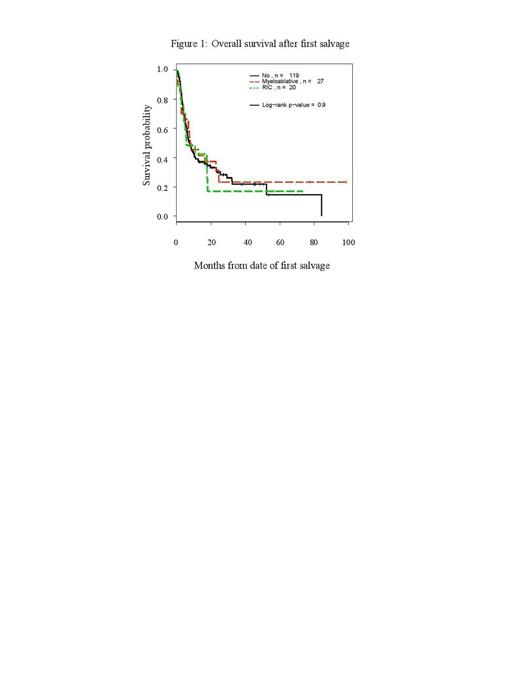Abstract
Purpose. Several studies have shown that allogeneic hematopoietic cell transplant (HCT) in first complete remission (CR1) reduces risk of relapse and improves relapse-free survival in patients with intermediate- and poor-risk AML. Benefits in overall survival (OS) are less obvious. One possible explanation is that once relapse occurs previous receipt of allogeneic HCT in CR1 is associated with shorter survival, with a lower CR rate following salvage therapy for relapse being a possible contributing factor. The aims of our study were to analyze the specific effect of allogeneic HCT in CR1 on (a) second CR rate and (b) OS from first salvage therapy.
Patients and Methods. We identified 166 consecutive patients with AML (APL excepted, but including MDS with 10-19% blasts) who after achieving CR1 with initial treatment relapsed and subsequently received first salvage therapy between 2005 and 2013 at our institution. We used chart reviews to collect data on: (1) age, (2) CR1 duration, (3) ECOG performance status at relapse, (4) cytogenetic category (ELN criteria for adverse, intermediate, "favorable", and "missing") at relapse, (5) allogeneic HCT in CR1 (yes vs. no, and then myeloablative vs. reduced intensity vs. no) and (6) intensity of salvage therapy: with high-dose cytarabine containing therapy or myeloablative HCT considered "high intensity", 3+7 +/- other drugs as average intensity, and other salvage treatments as low intensity.
CR was defined using conventional criteria. OS was measured from date of first salvage therapy to death from any causes analyzed using the Kaplan-Meier method. Multivariable regression analysis was performed using logistic and Cox models, adjusted for the 6 covariates noted in the preceding paragraph.
Results. The median age of the 166 patients was 53.5 years (20 - 80 years). The three groups differed regarding this variable (p < 0.001): a median of 47 years (22 - 66) in the 27 patient myeloablative group, 61 years (21 - 75) in the 20 patient reduced intensity group and 54 years (20 - 82) in the 119 patient no-HCT group. The median CR1 duration was 7.9 months, and CR1 duration did not differ statistically (p = 0.46) in the three groups: 11.5 months myeloablative group, 8.8 months reduced intensity group, and 6.4 months no-HCT group. Cytogenetic data were missing in 22 patients; in the remaining 144, 8% had "favorable", 67% intermediate, and 25% adverse risk cytogenetics with no statistically significant differences in distribution between the three groups (p = 0.27 considering all patients). The median PS was 1, with 19% of patients having PS ≥ 2. Patients in the reduced intensity group more often had PS ≥ 2 (40% vs. 19% for myeloablative and 16% for no-HCT) (p = 0.07). 52% received high intensity salvage therapy (including 4 who received myeloablative allogeneic HCT), 18% received average intensity, and 30% received low intensity. The three groups differed regarding intensity of salvage therapy (p = 0.04). 25% of reduced intensity patients received high intensity salvage vs. 44% of myeloablative and 59% of no-HCT. In contrast, 26% of no-HCT patients received low intensity salvage vs. 37% myeloablative group and 40% reduced intensity group. The CR2 rate was 37.9%. The median survival after first salvage was 7.8 months.
A multivariable analysis showed that HCT in CR1 had no significant effect on CR2 rate (OR 1.33, p = 0.50) or OS (HR 0.87, p = 0.55). In contrast, shorter CR1 duration and low intensity salvage were independently associated with a lower CR2 rate with favorable cytogenetic at relapse associated with a higher CR2 rate, while PS ≥ 2, low intensity salvage, and, to a lesser extent, shorter CR1 duration were similarly associated with poorer survival with favorable cytogenetic at relapse associated with better survival. An analysis of myeloablative vs. reduced intensity vs. no-HCT led to similar conclusions: myeloablative HCT p = 0.98 and reduced intensity HCT p = 0.29. Together with the Kaplan-Meier plots (Figure 1, log rank p = 0.90) the data suggest that neither myeloablative nor reduced intensity HCT in CR1 has an adverse effect on OS after first salvage.
Conclusion.There was no evidence that preceding allogeneic HCT in CR1 was associated with lower probabilities of CR2 or OS after first salvage therapy. We believe our results should encourage use of allogeneic HCT in CR1 with some confidence that this will not unfavorably affect CR2 rate and OS should post HCT relapse occur.
No relevant conflicts of interest to declare.
Author notes
Asterisk with author names denotes non-ASH members.


This feature is available to Subscribers Only
Sign In or Create an Account Close Modal